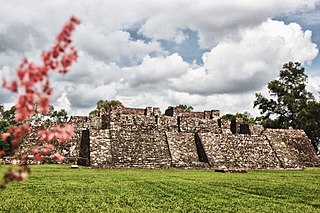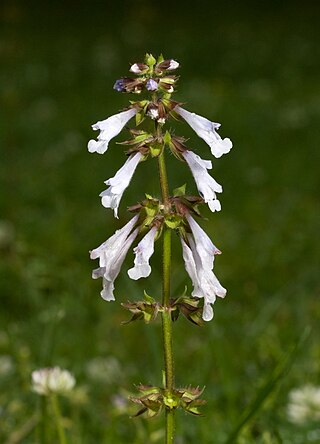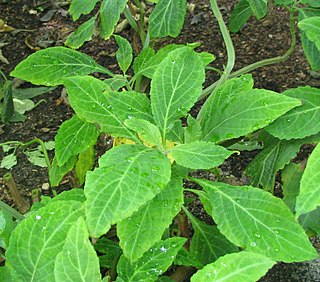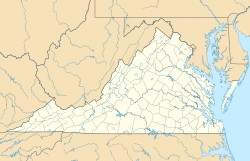
The Lamiaceae or Labiatae are a family of flowering plants commonly known as the mint, deadnettle or sage family. Many of the plants are aromatic in all parts and include widely used culinary herbs like basil, mint, rosemary, sage, savory, marjoram, oregano, hyssop, thyme, lavender, and perilla, as well as other medicinal herbs such as catnip, salvia, bee balm, wild dagga, and oriental motherwort. Some species are shrubs, trees, or, rarely, vines. Many members of the family are widely cultivated, not only for their aromatic qualities, but also their ease of cultivation, since they are readily propagated by stem cuttings. Besides those grown for their edible leaves, some are grown for decorative foliage. Others are grown for seed, such as Salvia hispanica (chia), or for their edible tubers, such as Plectranthus edulis, Plectranthus esculentus, Plectranthus rotundifolius, and Stachys affinis. Many are also grown ornamentally, notably coleus, Plectranthus, and many Salvia species and hybrids.

Salvia rosmarinus, commonly known as rosemary, is a shrub with fragrant, evergreen, needle-like leaves and white, pink, purple, or blue flowers, native to the Mediterranean region. Until 2017, it was known by the scientific name Rosmarinus officinalis, now a synonym.

Salvinorin A is the main active psychotropic molecule in Salvia divinorum. Salvinorin A is considered a dissociative hallucinogen.

Salvia officinalis, the common sage or sage, is a perennial, evergreen subshrub, with woody stems, grayish leaves, and blue to purplish flowers. It is a member of the mint family Lamiaceae and native to the Mediterranean region, though it has been naturalized in many places throughout the world. It has a long history of medicinal and culinary use, and in modern times it has been used as an ornamental garden plant. The common name "sage" is also used for closely related species and cultivars.

Salvia hispanica, commonly known as chia, is a species of flowering plant in the mint family, Lamiaceae, native to central and southern Mexico and Guatemala. It is considered a pseudocereal, cultivated for its edible, hydrophilic chia seed, grown and commonly used as food in several countries of western South America, western Mexico, and the southwestern United States.

Salvia apiana, the Californian white sage, bee sage, or sacred sage is an evergreen perennial shrub that is native to the southwestern United States and northwestern Mexico, found mainly in the coastal sage scrub habitat of Southern California and Baja California, on the western edges of the Mojave and Sonoran deserts.

Chia seeds are the edible seeds of Salvia hispanica, a flowering plant in the mint family (Lamiaceae) native to central and southern Mexico, or of the related Salvia columbariae of the southwestern United States and Mexico. Chia seeds are oval and gray with black and white spots, having a diameter around 2 millimetres (0.08 in). The seeds are hygroscopic, absorbing up to 12 times their weight in liquid when soaked and developing a mucilaginous coating that gives chia-based foods and beverages a distinctive gel texture.

The ancient Aztecs employed a variety of entheogenic plants and animals within their society. The various species have been identified through their depiction on murals, vases, and other objects.

Salvia lyrata, is a herbaceous perennial in the family Lamiaceae that is native to the United States, from Connecticut west to Missouri, and in the south from Florida west to Texas. It was described and named by Carl Linnaeus in 1753.

Rosmarinic acid, named after rosemary, is a polyphenol constituent of many culinary herbs, including rosemary, perilla, sage, mint, and basil.
Salvia divinorum, a psychoactive plant, is legal in most countries. Exceptions, countries where there is some form of control, include Australia, Belgium, Brazil, Canada, Denmark, Estonia, Finland, Germany, Iceland, Ireland, Italy, Japan, South Korea, Norway, Poland, United Kingdom, Ukraine, Spain, Sweden, Armenia and 33 states and territories of the United States.

Salvia divinorum is a plant species with transient psychoactive properties when its leaves, or extracts made from the leaves, are administered by smoking, chewing, or drinking. The leaves contain the potent compound salvinorin A and can induce a dissociative state and hallucinations.

Salvia is the largest genus of plants in the sage family Lamiaceae, with nearly 1000 species of shrubs, herbaceous perennials, and annuals. Within the Lamiaceae, Salvia is part of the tribe Mentheae within the subfamily Nepetoideae. One of several genera commonly referred to as sage, it includes two widely used herbs, Salvia officinalis and Salvia rosmarinus.

Salvia munzii is a semi-evergreen perennial species of sage known by the common name Munz's sage or San Miguel Mountain sage. It is native to northern Baja California, Mexico, and it can be found in a few locations just north of the border in San Diego County, California, where it is particularly rare. It is characterized by small leaves and clear blue flowers. It is a member of the coastal sage scrub and chaparral plant communities.
Jimmy LaSalvia is an American political figure. LaSalvia is the co-founder and former executive director of GOProud, a defunct U.S. political action group. He has also done work for the American Civil Liberties Union.
The legal status of Salvia divinorum in the United States varies, with 29 states having completely banned it and others considering proposals for banning its use.

HMS Salvia (K97) was a Flower-class corvette of the Royal Navy. She was ordered on the eve of the Second World War and entered service in September 1940. She rescued many survivors from the prison ship SS Shuntien when it was sunk on 23 December 1941. A few hours later, on Christmas Eve 1941, Salvia too was torpedoed. The corvette sank with all hands, and all of the survivors that she had rescued from Shuntien were also lost.

USCGC Salvia (WLB-400) was a United States Coast Guard Iris-class buoy tender in commission from 1944 to 1991. She operated in the Great Lakes and along the United States Gulf Coast during her career. Sold and renamed Brian Davis in 2020 for use as a memorial vessel, she was scuttled as an artificial reef in 2020.
















